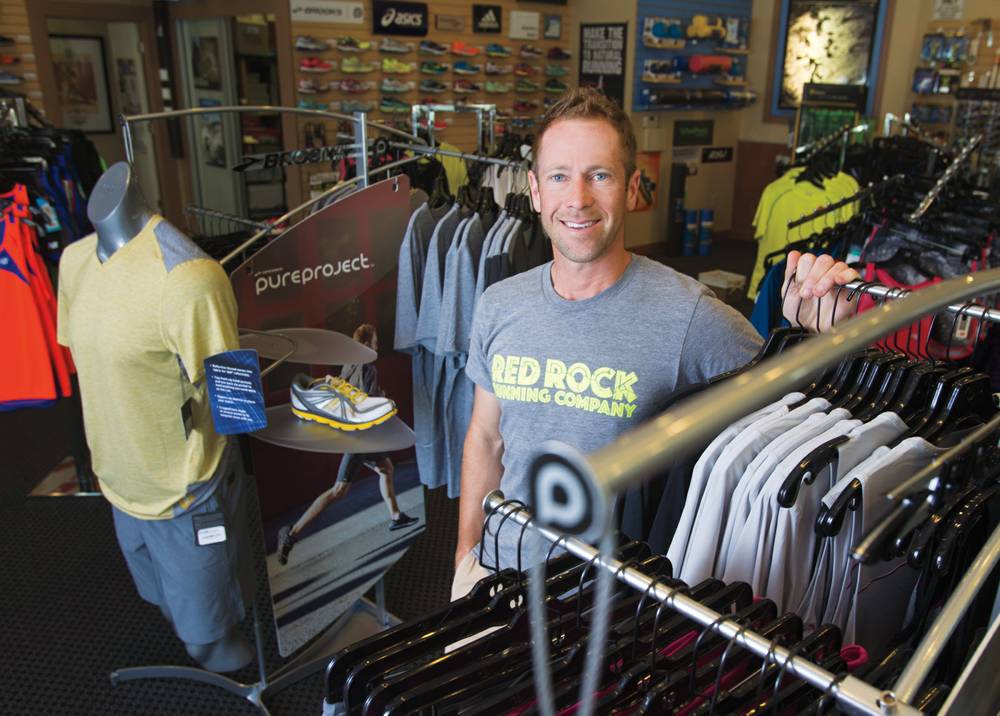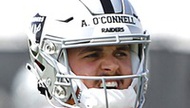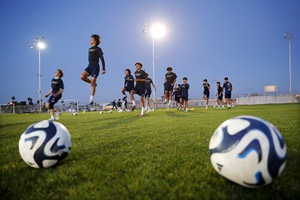Stomach issues, brutal blisters, 20-hour runs where your mind plays tricks and the only guarantee is that it’s going to hurt. Why would anyone endure that kind of physical and mental torture—let alone sign up for it? That’s what we asked Josh Brimhall, owner of local running store Red Rock Running Company and a member of Adidas’ AdiUltra team. For the 38-year-old ultramarathon runner, trail races up to 100 miles long are just part of the job, and those eyes in the dark aren’t a cougar—probably.
What was your first ultra? 2000. My brother and I drove up to Oregon to do a race called the Mount Hood PCT 50k. Thirty-one miles on the Pacific Crest Trail, great course, I lucked into it and I won it.
You won your first race? Yeah, spoiled right? I won the first one, but I really enjoyed the act of just running on the trails with like 100 people in the race.
Mentally, how is running an ultra different than a regular marathon? You’re out there a little longer obviously. It’s really easy to get down on yourself when you’ve been running for 14 or 15 hours. You’re tired, you’re dirty, you just want to clean up and take a nap. And the reality is you’re out in the middle of nowhere sometimes … you’re just forced to continue on.
What’s the longest you’ve spent on a course? Nineteen hours and 59 minutes. It was a 100-mile race in the Tetons. There are pros and cons to being fast, I guess, but one of the pros is you’re done sooner. I have a lot of respect for the people who are out there for 30 to 35 hours.
How do you stay fueled up and in good shape over the course of a race? You’re eating, you’re drinking, you’re managing stomach issues, you’re managing all sorts of things, feet issues. All those things you have to take care of immediately. You don’t want to let it linger until your toe’s going to fall off at mile 50, ’cause then you’re done.
What tricks have you picked up? Training. It all comes back to just training daily [and] appropriately, so when you get to the race your body’s not going to be thrown for a loop. … The simplest answer is just keep moving. It sounds so basic, but it’s really not as easy as it sounds at a certain point. You just don’t want to keep moving, but if you just get up out of that chair at that aid station and you just keep going, eventually you hit the finish line. But it’s amazing how powerful the mind can be sometimes.
Do you have a go-to snack or power-food? I wish. There are guys who are so amazing, their stomachs are iron. I subsist on, for a typical race, let’s just take a 50k, you can take a few gels and be okay. Fifty-mile, 100-mile, you need to start taking in a lot more calories. I’ll do synthetics for maybe the first five hours. Eventually you just get taste fatigue and you just can’t do another gel. Literally, you’ll vomit if it touches your tongue. You start moving over then to solid foods. You’ll look at the aid station and it’s sort of a smorgasbord of food. If chips look good, you take a handful of chips; M&Ms, sure. Whatever you can get in is great, but 300 to 400 calories an hour is what you’re shooting for.
After 100 miles, how does it feel to cross that finish line? Oh, you’re relieved; you’re very glad to be done. You’re out there for that long, it’s these little things you take for granted, like a shower, just a toothbrush at a certain point. I’ve thought about running with floss and a toothbrush because you eat so much gel and you just want to brush your teeth. Fifty bucks for a toothbrush at any aid station, I guarantee you’d sell out.
How often do you have to DNF (did not finish) or drop out? You see a higher DNF rate the longer the distance. If you’re at 40 miles and you’re already feeling bad—you’ve got massive blisters, you’re vomiting—it’s really hard to convince yourself that 60 miles is doable. Forty miles into a 50-mile race and you’ve trained really hard, a lot of times you can suck it up and shuffle in those last 10 miles. I’ve finished 65 ultras; I’ve started about 75 to 80. There are guys out there who are just tough; they finish no matter what. I’m not that guy. Some days it’s just not meant to be, and I don’t want to do any physical damage or mental damage, for that matter, so I just call it a day.
Was there a race that stands out as your hardest? In 2010 I ran on the U.S. trail team and we went over to Ireland. European trail running and American trail running, there are some similarities, but there are some pretty big differences, as well. They have trails over there, but they’re not opposed to running off-trail, they call it cross-country or fell running. So they might put a flag in the ground and you go from that flag to the next flag, but there’s no trail. Ireland, the course was kept under wraps because it was a world championship race, but there wasn’t much trail. You literally run through bogs, you run up over a mountain and right down the mountain.
Let’s talk training. How much do you run per week? Typical mileage per week ranges from 75 on the low end to 115 on the high end. It seems like a lot, but it’s funny how fast that mileage adds up. This morning I did 50 minutes and then tonight I head to the track to do another workout, and you know, that’s 17 miles for the day. … It’s a selfish sport. I have an understanding wife, thankfully.
Where do you like to run in the Valley? Where we live now, we bought our house there specifically because of its proximately to Bootleg Canyon. Our new home will also be right there within a half-mile of the trailhead. ... Bootleg is probably my favorite. Red Rock is great, it’s a no-brainer. Cottonwood trails are good. Charleston is great; it’s something that I wish I did more of, and if it wasn’t a 40- to 50-minute drive I’d be there everyday. And some of the newer trails, the McCullough Trail out in Henderson, that’s a great trail and they’re adding onto it all the time. I’ve never been up to Tule Springs yet, but I hear that’s some nice trail running up there.
What’s the coolest thing you’ve seen on the trails around here? You see lots of wildlife. Big horn sheep are out there all the time. You see the rattlesnakes from time to time. Desert tortoise, that’s pretty neat when you come across one of those. It’s more the weird stuff. I started running in Bootleg almost eight years ago before there was nearly the number of trails out there. And you’d see some things. Guys out there wandering around in the desert. There are a lot of homeless people out there, and people sleeping in cars, and people burying things, and people digging for stuff … I’d rather see the animals, honestly. It’s the people that make you the most nervous. And I’m sure they’re not keen on seeing me out there at 10 o’clock with my headlamp on.
You’ve spent some time in Copper Canyon, Mexico, with the indigenous Tarahumara people made famous for their long-distance running ability in the book Born to Run. I went down there the year after they were writing the story from the book. My main reason was, selfishly, I wanted to do some running, but I went down there for my master’s thesis to study the Tarahumara. … It was really cool to see that side of the world and just see those people. They run, but they don’t run for any reason that we run. They don’t understand the competitive side of running; that’s kind of silly to them. I was second in the race, and we won all this corn. It’s like 3 tons of corn and $5,000, so we just gave it to them.
People sometimes hallucinate during ultras. Has that ever happened to you? Not so much hallucinating, but the mind will play tricks. Some of the 100-mile races at night, you’ve got your headlamp on, you’re by yourself, in the mountains, you see a couple pairs of eyes. It’s probably a deer, most of the time it’s a deer, but you can make yourself think it’s a cougar, it’s a bear. Next thing you know your adrenaline’s spiking and you’re shouting randomly, just in case there’s an animal around the corner. I’ve done that. You don’t want to get eaten out there. It’s so funny how you can convince yourself, oh there are some eyes out there, it’s a cougar stalking me. But it’s not. … Probably not.
What’s your take on the Vibram FiveFingers shoes and the company’s recent settlement of a lawsuit claiming they falsely advertised the health benefits of the shoes? (laughs) I’m of the opinion that their faces should be posted, the lawsuit people. Yes, Vibram probably overdid it with the barefoot thing. I think their ad campaign was like, “It’ll strengthen your foot and keep you injury-free.” The reality is that there’s no such thing as a shoe that’s going to keep you injury-free. Fifty years of research kind of shows injuries have stayed about the same no matter what they do with footwear.
What’s your take on the barefoot running movement as a whole? Well, it’s not nearly as big as it was. We’re talking about a pendulum in our industry, about how the pendulum is kind of swinging back to more traditional footwear and more of a maximum story shoe with the Hoka now and the Altra. You see these phases every so many years. It sounds good, the minimalist story, it makes sense from a verbal thing: Yeah our ancestors ran barefoot. But again, you gotta look at why they ran barefoot and not in shoes—they didn’t have a choice. It was a different world; they weren’t running for sport. So, I get it, but it’s interesting to see people coming in with a pair of Vibrams in their hand. “These shoes hurt me. I want to go back to what used to work.” But we still have to have that conversation that injuries are usually people-driven, not footwear-driven. A lot of injury is just overuse. It’s a hard sport, it’s a high-impact sport. And if you’re not consistent and doing it a lot, the body doesn’t adapt, it just rebels. We just tell people, the more you can run, believe it or not, the less likely you’ll be injured because that body will play along with that.
Is running ultras fun? I ask myself that all the time. It depends on that specific time when you ask me. There are many times when I have said, “This is it. I don’t need to do this anymore. I can go do half-marathons and have breakfast.” But then there are times I think, “This is good. This builds character.” I know it’s cliché to say, but when you’re out there and that’s it, everything is reduced to eating, drinking, breathing, taking care of your body. You learn a lot about yourself. That’s the fun part, I think.








